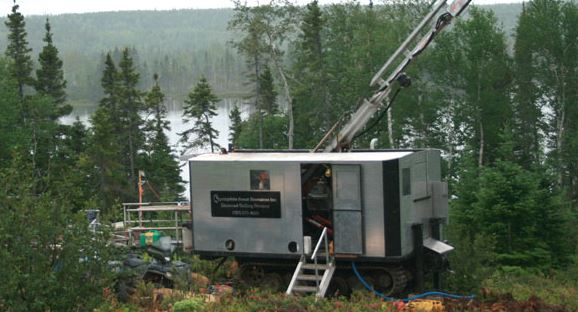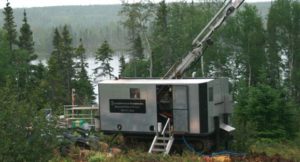Sokoman tables final Moosehead assays, stock down 38%

Diamond drilling on the Moosehead gold project in central Newfoundland. Source: Sokoman Iron Corp.

Sokoman Iron Corp. [SIC-TSXV] emerged as the volume leader on the TSX Venture Exchange Thursday after the company released final assays from phase two drilling on the Moosehead Gold Project in north-central Newfoundland.
However, investors reacted to those results by sending the shares down 38% or $0.085 to 14 cents on volume of 8.7 million. The shares trade in a 52-week range of $0.03 and 58 cents.
Sokoman leapt onto investor radar screens in July, 2018 when it announced that the first drill hole, MH-18-01, had returned 11.9 m of 44.96 g/t gold from 109 m to 120.9 m.
The company has described Moosehead as a very accessible orogenic lode gold project. It contains a mineralized system that remains virtually untested below a vertical depth of 100 metres.
The company said eight of the 15 holes completed in Phase 1 drill program reported visible gold-bearing quartz vein zones.
It said Phase 2 would focus on an area known as the Eastern Trend’s high-grade mineralization intersected in MH-18-01, and continue to build on open-ended zones of mineralization in the Western Trend as well as other areas of the property.
Results released Thursday are mainly from the Western Trend and historical targets up to one kilometre to the north and south of the Western Trend.
The results also include assays from infill sampling from MH-18-39 and two holes not previously reported on from the Eastern Trend. They are MH-18-37 and 40.
Eastern Trend highlights include drill hole MH-18-40, which returned 14.70 metres at 0.98 g/t gold, including 0.65 m of 13.00 g/t gold.
Hole MH-18-39 returned 9.05 metres at 70.29 g/t gold (including 5.10 metres of 124.21 g/t gold previously reported).
Hole MH-18-37 intersected 3.70 metres at 0.92 g/t gold, including 0.70 metres at 2.45 g/t gold.
“Results from holes MH-18-37 and 40 suggest they did not properly intersect the plane and newly recognized Eastern Trend shear zone, Sokoman said.
Sokoman said Phase 3 diamond drilling will begin immediately and will focus on targets identified from a preliminary structural evaluation recently completed on the Eastern Trend.
While ice thickness on North Pond is currently not sufficient to support drilling equipment, extensions to the Eastern Trend can be tested by land-based drilling, the company said.
Meanwhile, efforts to increase ice thickness by flooding at North Pond will continue.
“The 7,643-metre, thirty-five hole, Phase 2 drilling program has expanded the footprint of both the Western and Eastern Trends, with key step-outs to the North and South of the Eastern Trend discovery hole, MH-18-01, as well as the up-dip direction with the zone remaining open,” said Sokomon President and CEO Timothy Froude.
The Phase 2 drilling also resulted in the discovery of a potentially significant new zone of gold mineralization in MH-10-103, located approximately one kilometre north of the Eastern Trend in the general vicinity of a cluster of historical quartz vein boulders that were drill tested by previous operators in 2002.
Sokoman is a discovery-focused company with projects in Newfoundland and Labrador. While its primary focus is on central Newfoundland, it also has interests in early-stage gold, base metal and antimony projects in Newfoundland as well as a 100% interest in the Iron Horse rare earths project in Western Labrador.
